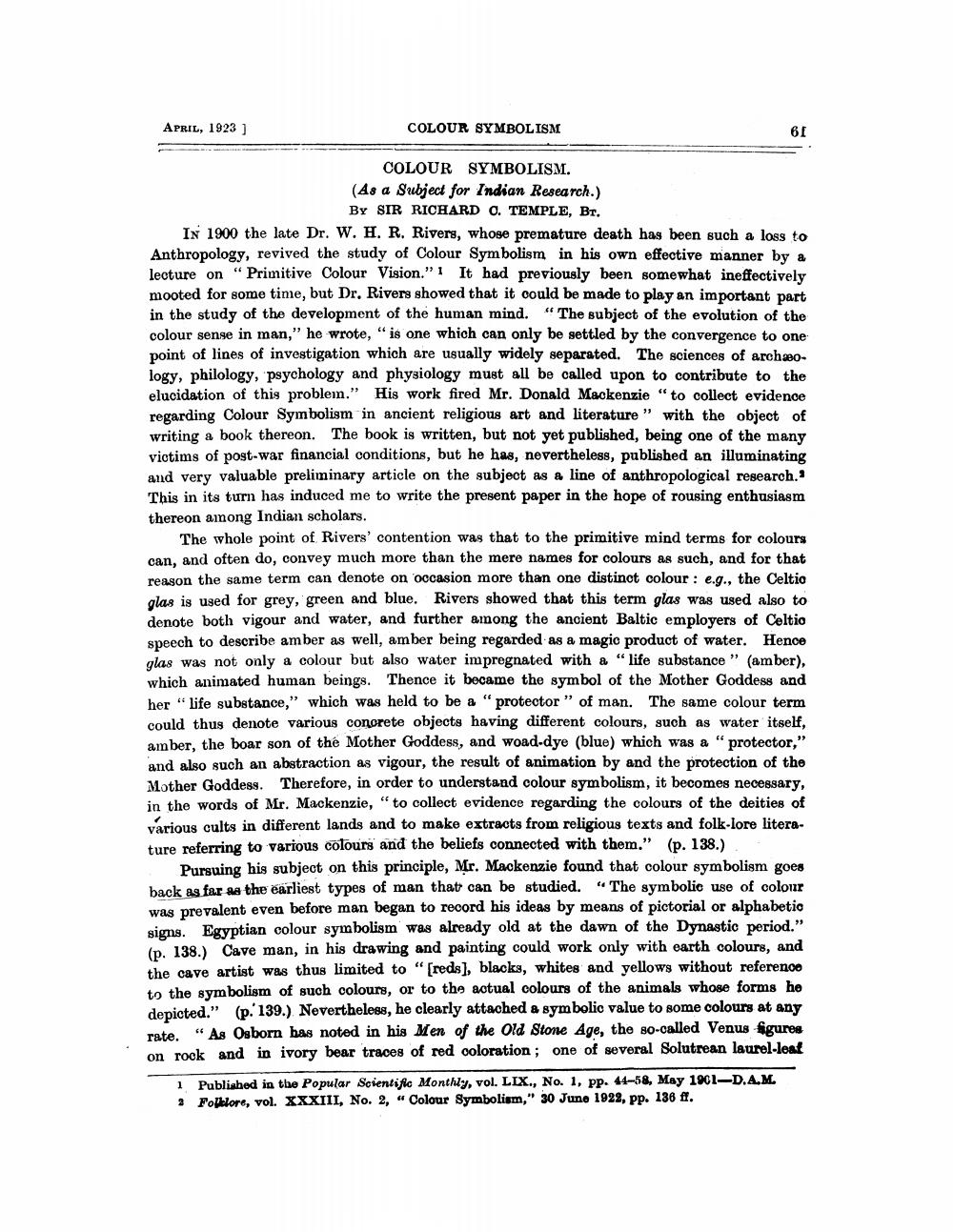________________
APRIL, 1923)
COLOUR SYMBOLISM
COLOUR SYMBOLISM. (As a Subject for Indian Research.)
BY SIR RICHARD O. TEMPLE, Br. IN 1900 the late Dr. W. H. R. Rivers, whose premature death has been such a loss to Anthropology, revived the study of Colour Symbolism in his own effective manner by a lecture on "Primitive Colour Vision." It had previously been somewhat ineffectively mooted for some time, but Dr. Rivers showed that it could be made to play an important part in the study of the development of the human mind. “The subject of the evolution of the colour senge in man," he wrote, " is one which can only be settled by the convergence to one point of lines of investigation which are usually widely separated. The sciences of archwology. philology, psychology and physiology must all be called upon to contribute to the elucidation of this problem." His work fired Mr. Donald Mackenzie "to collect evidence regarding Colour Symbolism in ancient religious art and literature" with the object of writing a book thereon. The book is written, but not yet published, being one of the many victims of post-war financial conditions, but he has, nevertheless, published an illuminating and very valuable preliminary article on the subject as & line of anthropological research." This in its turn has induced me to write the present paper in the hope of rousing enthusiasm thereon among Indian scholars.
The whole point of Rivers' contention was that to the primitive mind terms for colours can, and often do, convey much more than the mere names for colours as such, and for that reason the same term can denote on occasion more than one distinct colour: e.g., the Celtio glas is used for grey, green and blue. Rivers showed that this term glas was used also to denote both vigour and water, and further among the ancient Baltic employers of Celtio speech to describe amber as well, amber being regarded as a magic product of water. Hence glas was not only a colour but also water impregnated with a " life substance" (amber), which animated human beings. Thence it became the symbol of the Mother Goddess and her life substance," which was held to be a "protector " of man. The same colour term could thus denote various conorete objects having different colours, such as water itself, amber, the boar son of the Mother Goddess, and woad-dye (blue) which was a "protector," and also such an abstraction as vigour, the result of animation by and the protection of the Mother Goddess. Therefore, in order to understand colour symbolism, it becomes necessary, in the words of Mr. Mackenzie, "to collect evidence regarding the colours of the deities of various cults in different lands and to make extracts from religious texts and folk-lore literature referring to various colours and the beliefs connected with them." (p. 138.)
Pursuing his subject on this principle, Mr. Mackenzie found that colour symbolism goes back as far as the earliest types of man that can be studied. “The symbolic use of colour was prevalent even before man began to record his ideas by means of pictorial or alphabetic signy. Egyptian colour symbolism was already old at the dawn of the Dynastic period." (p. 138.) Cave man, in his drawing and painting could work only with earth colours, and the cave artist was thus limited to "[reds), blacks, whites and yellows without reference to the symbolism of such colours, or to the actual colours of the animals whose forms he depicted." (p. 139.) Nevertheless, he clearly attached a symbolic value to some colours at any rate. "As Osborn bas noted in his Men of the Old Stone Age, the so-called Venus figures on rock and in ivory bear traces of red coloration; one of several Solutrean laurel-leat
1. Published in the Popular Scientific Monthly, vol. LIX., No. 1, pp. 44-58, May 1901-D.A.M. 3 Folklore, vol. XXXIII, No. 2," Colour Symbolism," 30 June 1922, pp. 136 ff.




